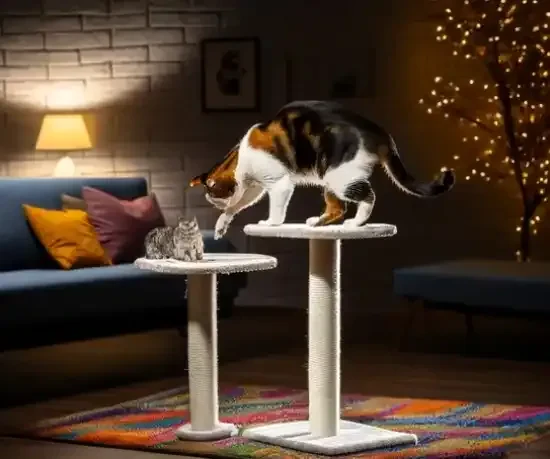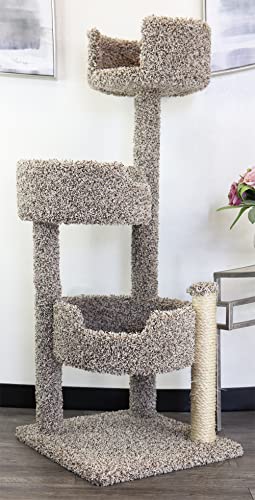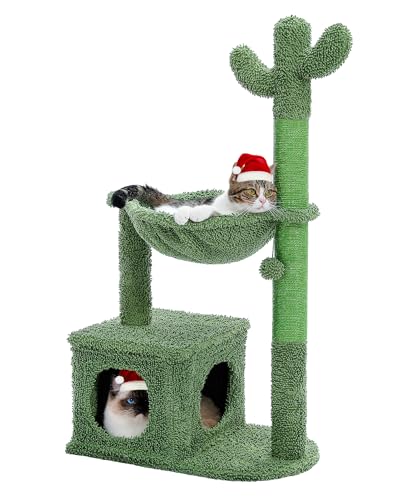Ah, the joy of cat ownership! The soft purr, the playful antics, the gentle head bumps – it's a relationship unlike any other. Yet, for many cat lovers, there's a common source of frustration that can sometimes mar this idyllic picture: the telltale scratch marks on the furniture. You adore your feline companion, but your once pristine sofa now resembles a well-loved scratching post, and the corner of your favorite armchair is fraying at an alarming rate. If this scenario sounds familiar, you're far from alone. Scratching furniture is a widespread concern for cat owners, often leaving us feeling exasperated and wondering if there's any way to preserve our homes from becoming feline playgrounds of destruction.
Before you resign yourself to a future filled with shredded upholstery and threadbare carpets, take heart. It’s crucial to understand that scratching is not a sign of feline malice or a deliberate attempt to annoy you. It’s a deeply ingrained, natural behavior for cats, as essential to them as purring or grooming. The good news is that with the right approach, preventing furniture scratching is not only possible, but also a far kinder and more effective solution than resorting to punishment or, even worse, inhumane procedures. This article is your guide to navigating the world of feline scratching. We’ll delve into why cats scratch in the first place, and, more importantly, equip you with a range of actionable strategies to redirect this natural instinct to appropriate outlets, effectively safeguarding your precious furniture and fostering a harmonious coexistence with your beloved cat. Understanding the “why” behind scratching is the very first step in finding a successful, long-term solution.
To truly tackle the furniture scratching problem, we need to understand the motivations behind this behavior. It’s not just random destruction; scratching serves several vital purposes for cats, all rooted in their natural instincts and needs. Firstly, and perhaps most fundamentally, scratching is essential for claw maintenance. A cat's claws are not static; they grow continuously, and the outer, older layers need to be shed regularly to keep the underlying claws sharp and healthy. Think of it like a feline manicure or pedicure. Scratching on surfaces helps to effectively remove these dead outer layers, revealing the sharp, new claws underneath, ready for climbing, hunting (even if just toy mice!), and gripping.
Beyond claw maintenance, scratching is a fantastic full-body stretch and exercise for cats. When a cat sinks their claws into a surface and pulls downwards, it allows them to stretch muscles and tendons throughout their body, particularly in their back and shoulders. Watch a cat scratch, and you'll see the full extension of their body, a powerful and satisfying stretch that feels good to them and keeps them limber and agile.
Scratching also plays a significant role in scent marking and communication. Cats have scent glands located in their paws, specifically between their toes. When they scratch, they're not just leaving visible marks; they're also depositing their unique scent onto the scratched surface. This scent marking serves as a form of territorial communication, both for other cats and, importantly, for themselves. Even indoor-only cats retain this instinct to mark their territory with scent, reassuring themselves in their environment.
Adding to the sensory message, scratching also creates visual markings. The shredded texture left behind from scratching acts as a visible signal to both feline and human eyes, further reinforcing their claim to a particular area. It’s a clear visual declaration, saying, "This is mine!"
Finally, scratching can also be tied to a cat's emotions. It can be a displacement behavior when they are feeling stressed, anxious, or even overly excited. Scratching might help them to release pent-up energy or to self-soothe in moments of emotional upheaval. Sometimes, it's simply a pleasurable activity, a way for them to express joy or contentment, much like a dog might wag its tail or a human might tap their foot when happy.
Now that we understand why cats scratch, it’s easier to see why furniture so often becomes the target of their scratching endeavors. Firstly, texture preference plays a significant role. Cats have individual preferences, but many are drawn to textures commonly found in furniture, such as carpet, upholstery fabric, wood, or even vertical surfaces reminiscent of tree trunks. The satisfying resistance these materials offer as they rake their claws down is often far more appealing than, say, a smooth plastic surface.
Location is another critical factor. Furniture is frequently placed in prominent areas of the home – near doorways, windows, social gathering spots – precisely the locations cats intuitively choose for visual and scent marking to maximize their territorial messaging. These are the areas they want to claim and make their presence known, both to themselves and potentially to any other animals in the vicinity (real or imagined).
Lastly, furniture is typically sturdy and stable. A good scratching surface needs to provide resistance so the cat can really dig in and get a satisfying scratch. Wobbly or lightweight scratching posts simply don't offer the same appeal as a solid, immovable piece of furniture that can withstand their full scratching force.
Given these ingrained instincts and furniture's unfortunate suitability as a scratching target, the key to preventing furniture damage lies in redirecting your cat’s scratching behavior to more appropriate outlets. This involves a two-pronged approach: providing enticing and acceptable scratching alternatives, and making your furniture less appealing as a scratching surface.
The cornerstone of successful scratch prevention is to offer your cat a variety of scratching surfaces that cater to their natural preferences. Think of it as creating a feline scratching buffet, offering different textures, orientations, and locations to meet their diverse needs. Scratching posts are the most common and readily available option. They come in various types: vertical posts resembling trees, horizontal logs for ground scratching, and angled ramps for a different scratching posture. Consider the materials: sisal rope is a classic favorite, mimicking tree bark; carpet can be appealing to cats who like to scratch carpets; cardboard provides a satisfying shreddable texture; wood offers a more natural feel; and even upholstery-style fabrics can be used on posts. Ensure any scratching post you choose is tall enough for your cat to fully stretch upwards when scratching – ideally, taller than your cat when fully extended. Stability is paramount; a wobbly post is unlikely to be used.
Scratching mats offer another great alternative, especially for cats who prefer horizontal scratching. These mats can be made of cardboard, sisal, carpet, or corrugated paper. They can be placed directly on the floor, wall-mounted, or even hung on doorknobs to offer different scratching angles. Scratching boxes and loungers take the concept a step further, combining scratching surfaces with comfortable resting or play spaces. These are often made of corrugated cardboard and can be incredibly appealing to cats who enjoy lounging and scratching in the same area.
If you're able to, consider incorporating natural scratching options into your home, especially if you have a catio or safe outdoor access. Safe tree branches, securely mounted indoors or within a catio, offer an authentic scratching experience. Designated scratching logs placed outdoors in a safe, enclosed area can also provide a natural and satisfying scratching outlet for cats who enjoy spending time outside under supervision.
Simply providing scratching surfaces is only half the battle; placement is equally crucial. Initially, place new scratchers very close to the furniture your cat is currently scratching. This immediate proximity makes it easy for them to transition to the new, acceptable surface. High-traffic areas, such as social spaces, near windows, and doorways, are prime locations for scratching posts as these are naturally where cats want to leave their visual and scent marks. Offer scratchers in multiple locations throughout your home, rather than just one, to provide options and encourage scratching in various areas. Pay attention to where your cat is currently scratching and try to mimic those preferences when choosing and placing new scratchers. If they prefer vertical surfaces, opt for tall posts; if they prefer horizontal surfaces, scratching mats are a better bet. Observe their preferred textures and try to offer similar materials in your scratching alternatives.
To maximize the appeal of your new scratching surfaces, employ a few enticing tricks. Catnip is a potent attractant for many cats. Sprinkle a little catnip on or near the scratcher to draw their attention (use sparingly initially to avoid overstimulation). Engage your cat in play around the scratcher, using toys to encourage interaction and create positive associations with the scratching post or mat. Positive reinforcement is key. Whenever you see your cat using the appropriate scratcher, immediately reward them with treats, praise, and petting. Make using the scratcher a positive and rewarding experience. For scent marking purposes, you can optionally try rubbing the scratcher with your cat's scent. Use a soft cloth to gently rub around their cheeks or body and then rub that cloth on the scratcher to transfer their familiar scent, marking it as “theirs.” Make scratching fun! Ensure the scratcher is an engaging part of their environment. Dangle toys from it, incorporate it into playtime, or create interactive games around it to make it a fun and stimulating part of their day.
While making scratching posts and mats irresistible, you also need to make your furniture less appealing. This is where deterrents and barriers come into play. Texture aversion is a powerful tool. Cats generally dislike sticky textures. Double-sided tape applied to furniture corners or areas being scratched can be a highly effective deterrent. Aluminum foil or plastic wrap can also create an undesirable texture. Commercially available sticky paws or similar adhesive products are specifically designed for furniture protection and are safe for pets.
Scent deterrents can also be useful. Many cats have an aversion to citrus scents. Use citrus-scented sprays (always test on a small, inconspicuous area first to ensure they don't damage the furniture finish) or place citrus peels nearby to deter scratching. Commercially available deterrent sprays are formulated with scents that cats find unpleasant but are generally safe for pets. Always choose pet-safe deterrent sprays and follow product instructions carefully.
Physical barriers provide direct protection. Furniture covers, such as slipcovers, throws, or blankets, can protect vulnerable areas, especially during the initial redirection phase. Clear plastic furniture protectors are available as sheets or pre-shaped corner protectors that can be placed over furniture to physically block scratching access. Scratch guards are specifically designed commercial products that attach to furniture corners to provide a durable, scratch-resistant barrier.
Consider furniture rearrangement to minimize temptation. If possible, slightly rearrange furniture to make the previously tempting scratching spots less accessible or less prominent in your cat’s territory. If necessary, temporarily block access to particularly tempting furniture areas with furniture placement or barriers during the training process.
Beyond providing scratching alternatives and deterrents, nail care plays a crucial role in minimizing furniture damage. Regular nail trimming is a vital component of preventing destructive scratching. Trimming your cat's nails doesn't eliminate their need to scratch entirely, but it significantly reduces the damage they can inflict. Trimmed claws are less sharp and less likely to snag and tear fabrics. Aim to trim your cat's nails every 2-4 weeks, depending on their individual nail growth rate. If you're new to nail trimming, ask your veterinarian or a groomer for a demonstration. The key is to handle their paws gently, only trim the very tip of the nail, avoiding the pink quick (which contains nerves and blood vessels), and use sharp, cat-specific nail trimmers. Make nail trimming a positive experience by offering treats and praise during and after the process. Start nail trimming early in your cat's life to acclimate them to the routine. Even with trimmed nails, cats will still scratch, but the damage will be significantly less severe. Beyond furniture protection, regular nail trimming also benefits your cat by reducing the chances of their claws getting caught in carpets or fabrics and preventing painful scratches for you and other humans in the household. It can also make walking more comfortable for older cats or those with mobility issues.
Redirection and positive reinforcement are essential training techniques to guide your cat towards appropriate scratching behavior. If you catch your cat scratching furniture, gently interrupt the behavior. A simple verbal "No," or a clap of your hands (not too loud or startling), is usually sufficient. Avoid yelling or physical punishment, which will only scare your cat and damage your bond. Immediately redirect your cat to a nearby scratching post or mat. Make the scratcher appealing in that moment. Use a toy to engage them in play around the scratcher, sprinkle a little catnip on it, or offer verbal praise. Positive reinforcement is absolutely crucial for long-term success. Whenever you see your cat using their designated scratcher, immediately reward them with treats, verbal praise, and petting. Create a consistent positive association between scratching the appropriate surfaces and receiving rewards. Patience and consistency are key. It takes time and repetition for cats to learn new habits. Be consistent with redirection and positive reinforcement, and your cat will gradually learn to prefer their scratchers over your furniture.
Crucially, there are methods you should never employ to stop furniture scratching. Punishment and scolding are not only ineffective but can actually worsen the problem and damage your relationship with your cat. Cats don't understand punishment in the way we do. They won't associate your scolding with scratching furniture; they'll associate it with you, becoming fearful or anxious in your presence. Punishment can increase anxiety and stress in cats, which ironically, can lead to more scratching as a stress response. Focus on positive guidance, not negative reprimands. Instead of scolding, focus on redirecting and rewarding appropriate scratching behavior.
Declawing is another method that should be strongly and unequivocally avoided. Declawing is not simply nail removal; it's a surgical amputation of the last bone of each toe, akin to amputating the fingertip at the first knuckle in humans. It’s a painful surgery with a long recovery period and carries the potential for chronic pain, nerve damage, and complications. Declawing can lead to numerous behavioral issues, including increased biting as a defense mechanism (having lost their claws, biting becomes their primary means of self-protection), litter box avoidance due to pain associated with digging in litter after surgery, and increased anxiety and frustration. From an ethical standpoint, declawing is widely considered inhumane and unnecessary. Humane alternatives, as outlined in this article, are readily available and far more compassionate. Choose humane methods and protect your cat's well-being.
Even with the best prevention efforts, some furniture damage might have already occurred. For existing scratches, cosmetic repairs can help. For wood furniture, touch-up markers or furniture polish can help minimize the appearance of scratches. For upholstery, patching or darning techniques may be used, or you might consider professional upholstery repair for more significant damage. However, remember that repairing existing damage is only a temporary fix if the underlying scratching behavior isn't addressed. Focus on prevention moving forward to protect your furniture long-term. Ongoing maintenance is essential for sustained success. Scratching posts and mats wear out with use. Replace them regularly to ensure they remain appealing and effective scratching surfaces. Maintain your regular nail trimming routine. Re-apply deterrents as needed, as scents can fade and sticky surfaces can lose their adhesiveness. Continuously observe your cat's scratching behavior and be prepared to adjust your strategies as needed. Cats' preferences can change over time, so ongoing monitoring and adaptation are key to long-term furniture protection.
Preventing furniture scratching is absolutely achievable with understanding, patience, and a multi-faceted approach. By providing enticing scratching alternatives, making furniture less appealing, practicing consistent positive reinforcement, and maintaining regular nail care, you can successfully redirect your cat’s natural scratching instincts to appropriate outlets. Remember to focus on positive guidance and avoid harmful methods like punishment or declawing. With consistency and the right strategies in place, you can create a harmonious home where both you and your beloved cat can happily coexist, furniture intact, fostering a lasting and loving relationship built on respect for feline nature and the joy of shared companionship.







